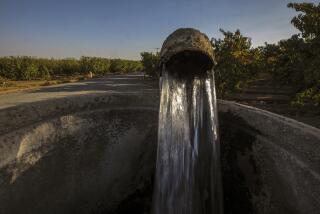Water, Water Everywhere--Today, Anyway
- Share via
DOUGHERTY VALLEY — There is no community of Dougherty Valley, at least not yet. The Contra Costa County town exists only on blueprints--a development of 11,000 homes, adorned with restaurants, parks, schools, bike paths, the works. For now, though, only cattle wander the foothills that rise up from the valley floor and roll out to Mt. Diablo.
Similarly, there is no Bear Creek yet, no Gold Rush City or Pacificana, no Rio Mesa or Riverbrook or Diablo Grande or New Jerusalem or Villages at Dry Creek. They are coming, though, they are coming. Dougherty Valley and these other places with pretty names are among 33 “new towns” listed in a controversial report circulating among California policy-makers.
The report’s central assertion is that nearly all these new towns--with a collective population of more than 850,000--have been approved by local officials without serious consideration of water supplies. This might seem strange, given California’s long history of water wars and its recent encounters with severe drought. In truth, planning whole towns without planning for water fits perfectly with longstanding native attitudes. Pioneer farmers in the dry reaches of the San Joaquin Valley had a hopeful, if unfounded, saying: Rain follows the plow. A century later, the thinking remains the same, except that, instead of plows, water is supposed to somehow magically chase pink stucco houses with adobe roofs.
“The whole history of this state,” said Randele Kanouse, government affairs manager for the East Bay Municipal Utilities District, “is you create the demand and the water will follow: Build it, and they will come.”
*
It was East Bay MUD that, a few years ago, put Dougherty Valley on the California water wars map. Its board then dominated by environmentalists, the water district went to court to block--temporarily, it turns out--the mammoth development. It argued that Dougherty Valley could not be serviced without jeopardizing reliable supplies to existing customers. Subsequently, state legislation has been proposed that would link development decisions with water supply. To rally support for these bills, Kanouse has begun to catalogue so-called new towns.
“Whose water,” he asked, pointing to the 33 dots on the map, “is going to be mortgaged, stolen or shared to meet these county plans? Every drop of water in California is put to some use by somebody, and in fact there isn’t enough to go around now. These counties have set in motion the creation of demand--with zilch effort to develop the water supply to meet it.”
Kanouse insists the “water first” movement is not intended to stop growth--but only to force earlier planning for the water needed to sustain it. The most stringent of the proposed laws would require water supplies to be lined up before a development was approved; others merely attempt to stimulate more discussion about water by urban planners. The concept seems simple, but in California water politics, nothing is ever simple.
One department of the Wilson Administration, for instance, publicly supports linking future growth to water supply; another opposes it. Farm organizations favor the approach as a way to protect farmland from suburban sprawl; individual growers privately voice discomfort with anything that might someday make it more difficult to sell out to developers. Most environmentalists like the more stringent bill; some worry it could backfire and create a push for more and bigger water projects. Developers, chambers of commerce and county officials regard the movement as a crass ploy by no-growth advocates to muscle in on community planning decisions; manufacturers worried about a certain water supply. . . .
And so on.
*
As perilous as the politics may be, Kanouse and his allies have faced a greater nemesis this year: rain. It started raining New Year’s Day in Northern California and seemingly has not stopped since. The reservoirs are loaded. Every river, creek and stream north of the Tehachapi is running fast and full. The Sierra is packed with snow that has only begun to melt. There’s another old saying: You never miss the water till the well runs dry.
“It’s hard,” Kanouse said, “to get people interested in water issues right now.”
As a result, he does not expect any of the proposed legislation to pass this year. Maybe in the next year or two it will rain a little less. Or perhaps it will take a few of the new towns to go up first. When pipes start coughing out air, maybe then the fantasy that California can keep growing today and finding water tomorrow might undergo a re-examination. Then again. . . .
More to Read
Sign up for Essential California
The most important California stories and recommendations in your inbox every morning.
You may occasionally receive promotional content from the Los Angeles Times.














